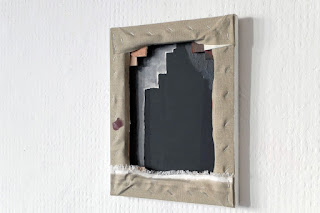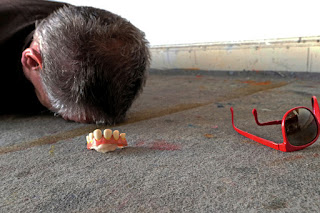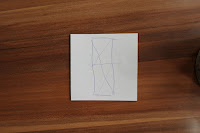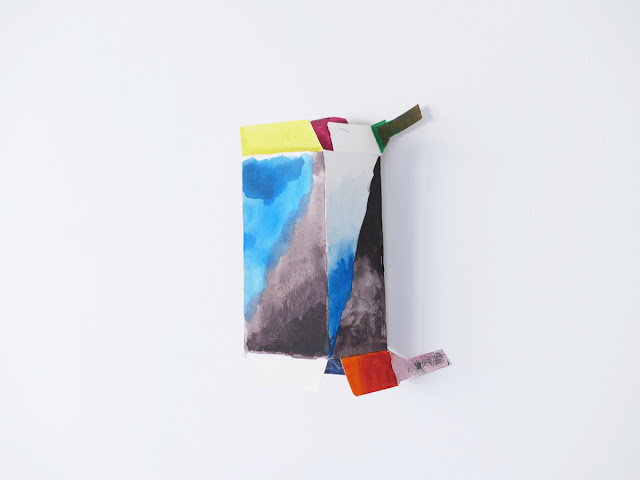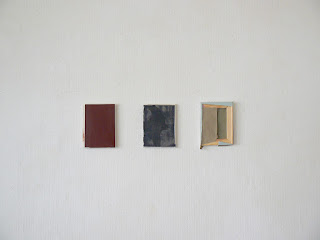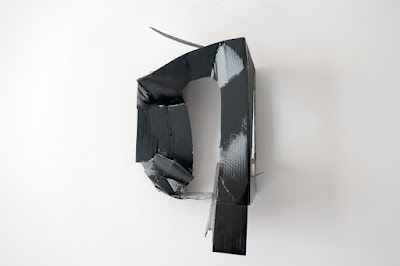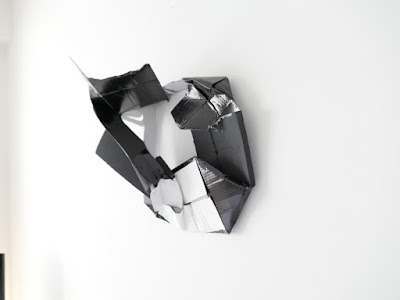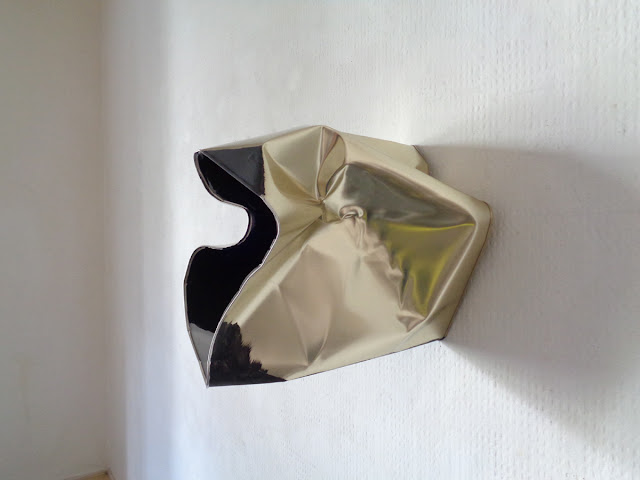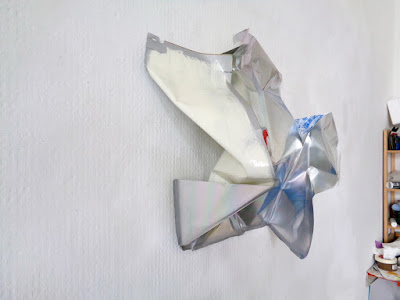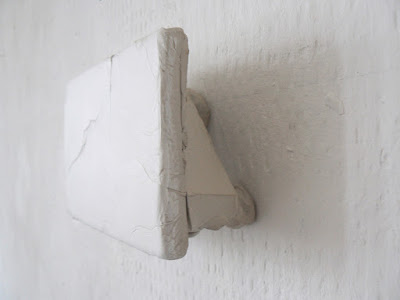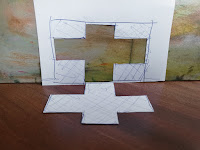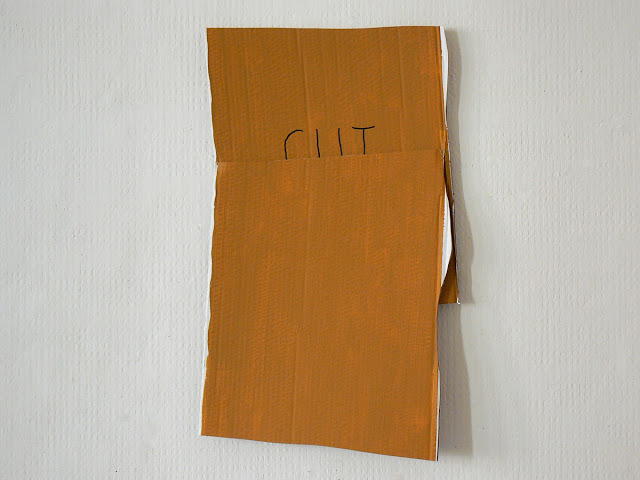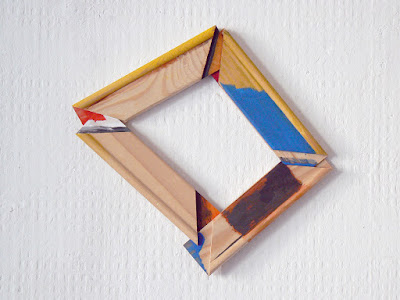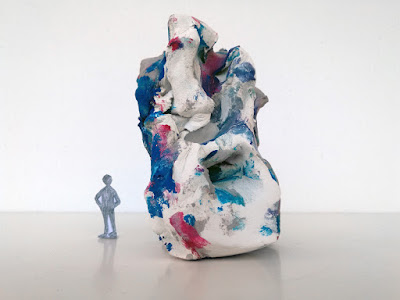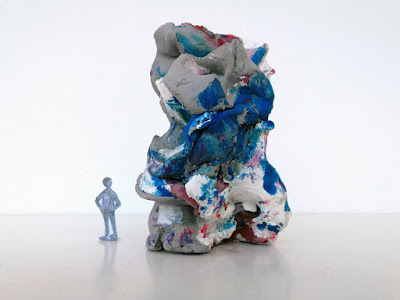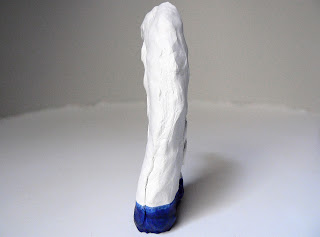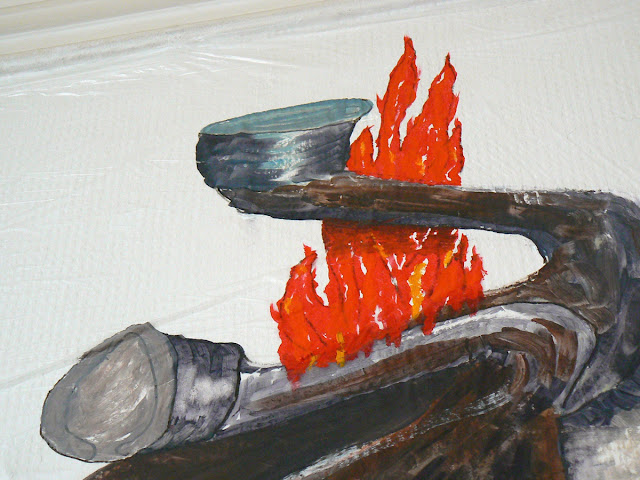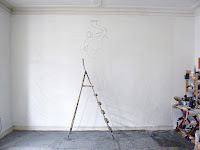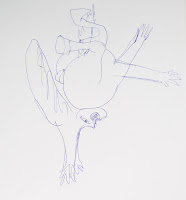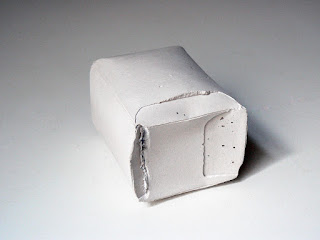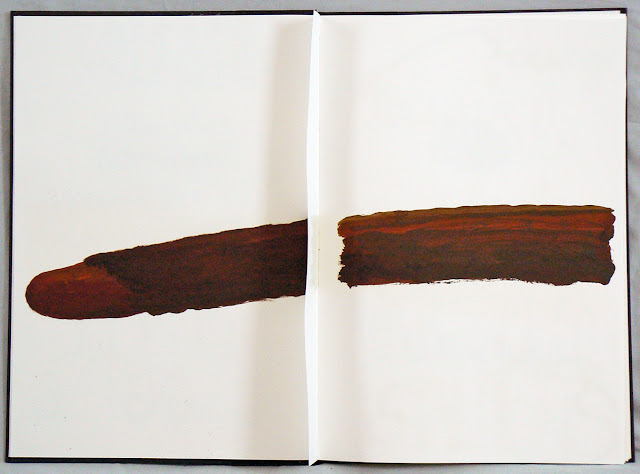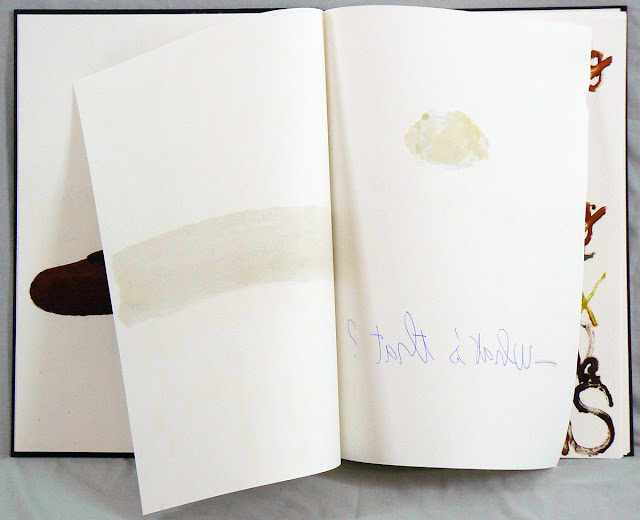Click on a pic to enlarge it. / Another year by clicking on 'older posts' at the foot of the page. / Link to Papers and Curated shows at the bottom.
---
 |
| Vertigo, 2019, 24x18cm (9.5x7.9"), acrylic and oil on canvas; currently on it's way to Philly as a present for somebody i don't know but who likes it sincerely i believe. |
---
---



---
 |
| House, cut-out and gouache on cardboard box. |
Summer homework 2019: House, 47x42x30cm (18.5x16.5x11.8"), acrylic and oil on cut cardboard box. / In a certain way, a house is a volume, often a parallelepiped, perforated with openings, parallelograms. / This therefore must be a house built on a cliff. Beware of the falls!
---
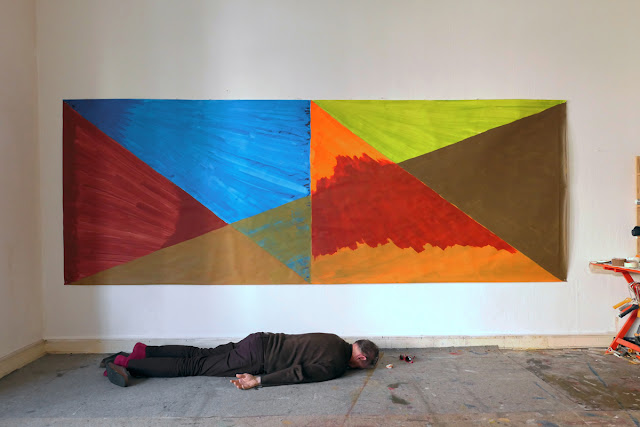 |
| Lemme tell ya its a killa, acrylic on paper. |
'Lemme tell ya it's a killa' (flattened prism), 2019; 150x410cm (59x161"), acrylic on paper. / A close friend had the good idea to give me a big piece of Fabriano... Thanks, Barbara! / It is by looking at 'Lipton', previously posted, that I grasped that there is an obvious, and perhaps even necessary, relationship between the two works, this one being a sort of projection of the first, its representation in two dimensions. Of course the two things are crossed by my wild imaginings concerning the fundamentally abstract nature of any image, figurative or not, and by the references to the pre-Renaissance Italian painting... one is as one is and one remains it.
---
 |
| Lipton, gouache on a Lipton box. |
Summer homework 2019; Lipton, 30x9x7cm (12x3.6.3x2.8"); gouache on Lipton's tea box, turned inside out. / Or how a little color can slow down, accelerate, transform, the perception of a volume in space.
---
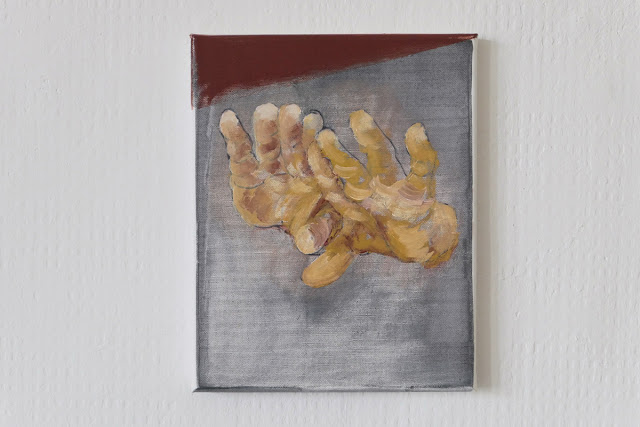 |
 |
His hands. I made this lill painting for Barbara, who invited us yesterday, Laurence Grave and i, to a donner recalling the death of her man, Mathias Wild, close friend, good painter, good drawer, acute and witty intelligence. He passed away October 21, two years ago. The oil was still wet but we found a way to transport the painting. Mathias's hands, 30x24cm (11.8x9.5"), marker, acrylic and oil on canvas.
---
 |
| Migrant, acrylic on cardboard box, cut-out. |
Migrant, 110x90x43cm (43x35.5x17"), acrylic and Gesso on folded cardboard, 2019. / Laurence Grave and i have plans to leave Berlin and move to Brussels. We had found a good place and i was starting to pack our stuff, but eventually things went awry and we will start looking again next year. Well, then, i used one of the moving boxes...
---
 |
| Oily trinity, cut-out, silicone and oil on canvas |
There are days like this, in the invigorating sunlight of which i still can't find the strength, the courage ... the energy, the desire, let's say, to write even a very short comment in order to escort the photo that i will post. It's true that to write three shabby lines in English, that would take fifteen seconds to a native, costs me thirty-one minutes of work and reflection, with a good automatic translator at hand. And please don't think i'm exaggerating. And yet we know that a small text may be important to the extent that it accompanies, that it introduces the wonderful apparition of a brand new, fragile being, just as a midwife also participates, and actively! of the terrestrial emerging of a form that is both common and particular, banal, but also unique, in a way, perhaps, who knows. Some excuse themselves from doing it. From the comment i mean. It is a birth without blessing. Some also don't give infos about technique and dimensions, which i find a shame. Some even scorn the hashtags! which are to Instagram what the gas is to Rolls-Royce. Without petrol, the most opulent car, the most expensive one is just a pile of scrap soon rusty. But finally, if they are satisfied with their twelve 'likes' at the end of the day, it's good for them as for me, huh, i don't really care. That said, sometimes one tries to do well, one pushes... nothing comes ... We bend, we stoop, we focus ... nada. It must be a form of mental constipation. Which is better after all than to indulge in a chatty verbiage, prolix and incoherent. Because as you see i strongly disapprove these kind of verbal diarrhea that is only there to deceive, as if nothing else mattered but to fill the space with disjointed sounds, or to stain the page with ink and signs. / The oily trinity, 2019; 24x18cm (9.5x7.9"), 28x22cm (11x8.7"), 30x24cm (11.8x9.5"), cut-out, collage, acrylic, silicon and oil on canvas.
---
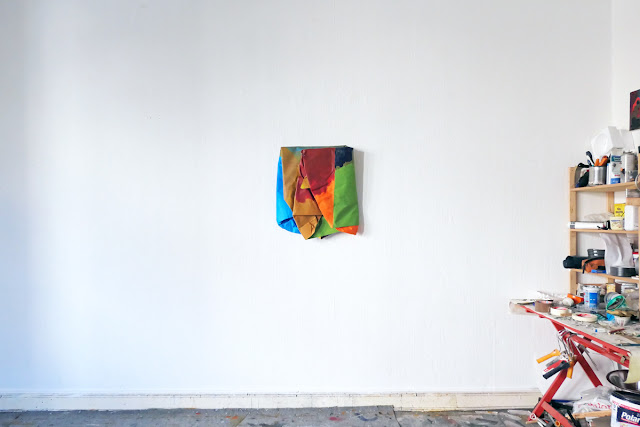 |
| Raw material for a cannibal feast, paper and acrylic. |
---
 |
| Sunset, 185x185cm (73x73"), glycerophtalic paint and oil on canvas. |
The rise and fall of the academism (sunset), 2019, 185x185cm (73x73"), enamel and oil on canvas, cut, video (visible on Instagram: @michelcarmantrand).
---
 |
| Eggs |
Resemblance is a true issue (though not necessarily seen or apprehended from the right place). As i think of the touching baby that we wonder, hardly out of the womb, if he looks more like Dad or Mom or Grandma, or thinking for example, among many others, of the German approach (nose: hooked) or of American one (skin: black, red, yellow, green) of discrimination, it appears that the question is complex and would have to be examined with caution. Try for instance to make a cake with these eggs. In very very short, skipping the intermediate steps, maybe that common and banal neurotic fantasy is less linked to what brings (us) together than to what excludes, and that if we hasten so much to find some resemblance to the infant's face, it is perhaps to prevent ourself from hating the stranger. A matter of proportions, a quota story.
--- Three:
Three, 2019; 24x18cm each (9.5x7.1"), cut-out, collage, acrylic and oil on canvas.
---
 |
| Untitled, 300x400cm (118x157"), acrylic paint and oil on prepared (gesso) tarpaulin. |

---
---
---
---
---
Portable anthropology:
 |
| Portable anthropology: paint, oil, acrylic, gesso, wood, plaster, cut, paper, cardboard, charcoal, ink, tape, flint, collage, glue, pen, and so on. 1996-2019. A kind of temporary synthesis. |
 |
| Plaster cast of my foot wrapped in aluminum foil. |
 |
| The hand of my mother, synthetic clay. |
 |
| Both, gesso and oil and dirt on canvas 50x50cm (19.7x19.7"). |
 |
| Cardboard boxes, acrylic and oil on folded cardboard boxes. |
---
 |
| The square, acrylic and oil on canvas, 20x20cm (7.9x7.9"). |
---
 |
| Dialectic extent, 18x18x19cm (7x7x7.4"), air dry clay. |
---
 |
| Fragment, collage, cut, montage, glue, acrylic, oil on paper and cardboard. |
 |
| Summer homework with paper, 140x145x40cm (55x57x15.7"), gouache on Fabriano. |
 |
| Two parts, 25x19cm (10x7.5"), Kermolin and wood. |
---
 |
| Narrowing and stressing the white in that third version of the The three musketeers. / 100x80x4cm (39.4x31.5x1.6") each. Gesso, acrylic, spray, Bic and oil on canvas. |

---
 |
| The three musketeers, 100x80x4cm (39.4x31.5x1.6") each. From left to right, d'Artagnan, Porthos, Athos and Aramis. Gesso, acrylic, spray, Bic and cut linen mounted on canvas. |
---
---
---
 |
| Tabouret, Gesso and oil on ceramic clay. |
---
---
 |
| U, Gesso, charcoal, lacquer paint and oil on wooden box. |
 |
| Monique Grave next to Unreadable, 185x185cm (73x73"), lacquer paint, oil and spray on canvas. / Dedicated to Carol McMahon, who after my 'Jews' had suggested to me to paint a 'Catholics'... |
 |
| Watershed, 300x200cm (118x78.7"), acrylic on prepared (gesso) tarpaulin. |
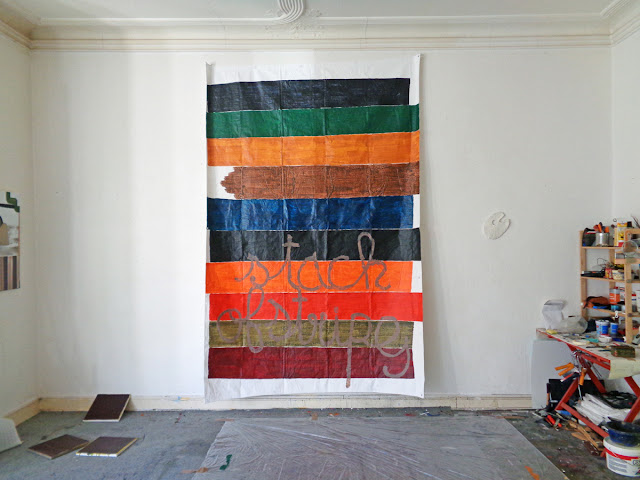 |
| 2019, Stack of stripes, 300x200cm (118x78.7"), acrylic on prepared (gesso) tarpaulin.
---
|
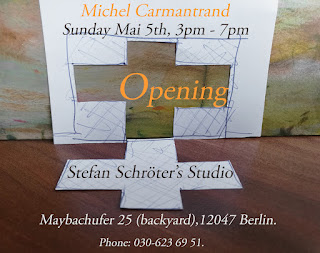 |
| Opening. I had little presentation in Stefan Schröter's studio. Acrylic on tarp, cut, oil on cardboard, plaster in aluminium box. |
---
---
---
 |
This is a little documentation on the making of Notre-Dame, a video about the fall of the spire. The video itself is to be seen on Instagram: @michelcarmantrand.
|
---
---
 |
| 2parts, Gesso, Bic, acrylic and oil on prepped cardboard |
---
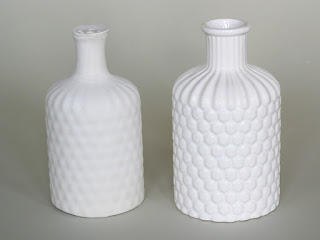 |
| The inside and the outside, two parts around 20x11cm (7.9x4.3"), ceramic and plaster |
 |
|
Sketch for a bigger painting, 460x600cm (181x236"),
Gesso, pigments and acrylic on tarp.
|
I'm afraid that I wasn't clear enough in my head at the start of
the project, especially on the choice of colors. I groped a bit and it affected
the result. Moreover, my constitutional dyslexia made me make a big mistake in
that I reversed the letters correctly so that I could keep the traditional
sense of reading in the result, by flipping the sheets of under the edges of
the tarpaulin, but I wrote the word itself as a mirror image and ... well, my
English is not good enough to explain it, but in short, I messed up. I post it
as a draft for a future painting, similar but better done, and probably larger.
---
 |
| Crumpled, variable dimensions, Gesso and pigments on tarpaulin. |

Separating physically, by cutting, volume and distance, two elements which at the beginning were but one: a flat surface entirely painted and traversed by a network of stripes. Therefore obtaining two distinct forms, visually united however with a recognizable pattern on the "volume" and on the "frame". Does it work, and how can we name the result? Painting, Installation? Sculpture? Naming things is an important part of the activity of those concerned with art, but also of all those who are not interested in art. It is a basic fact.
---
---
 |
| Window, 17x18x11cm (6.7x7x3.3"), aluminium box and plaster |
 |
| Surfacesupport j'adore, 300x400x300cm (118x157x118"), acrylic and découpage on tarp. |
I took up the classic theme
of the window in the painting as window and applied to it a more concrete
solution than in the illusionist practice, by cutting the material. The surface
was painted entirely, and behind, I painted the shape respecting the texture,
the ductus of the front. If one is not attentive to the hinge function of the
bottom of the canvas, one can believe that the painted surface was simply cut
off, and the cut placed at the bottom of the tarpaulin on the ground, which is
not the case. The title refers naturally to the artistic movement Supports/Surfaces.
---
 |
| untitled, 300x400cm (118x157"), découpage and acrylic on tarpaulin |
Normally the numbers are written one after the other. They are juxtaposed and written serially, chronologically, in a certain way. So that they are recognizable and understandable, either to form numbers, to carry out operations, to specify a date or a result, they must keep always the same shape, with variations of fonts. What could I do with 1, 2 and 3 that leads to a particular form from which the conventional meaning would be excluded? Just overlay them. I had already made an attempt in this direction in 2017, with letters (pic below), by writing all the letters of the alphabet on a square canvas, but turning the frame on the right with each new letter.
---
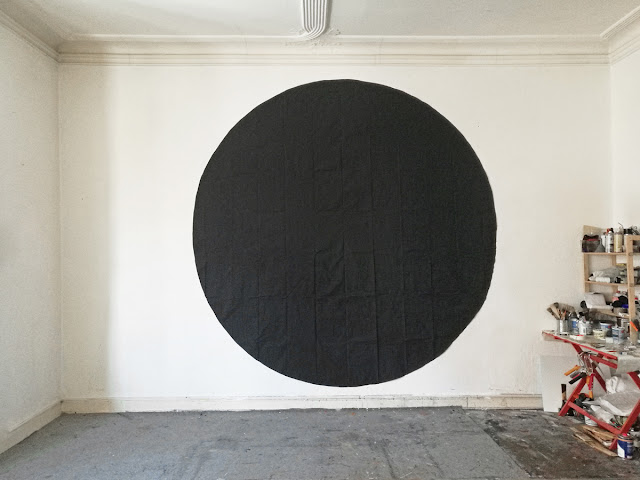 |
| Full Hole, 300x400cm (118x157.5"), lacquer paint on tarpaulin |
 |
| CUT, 300x400cm (118x157.5"), oil on tarpaulin |
CUT is a piece that, with its soft letters, plays with the boundaries between painting, installation and sculpture. Reflection and a kind of mirror image also play a big role in it. How to figure the backside of a letter?
--- |
| Sketch for a forthcoming painting on tarpaulin, 70x43cm (27.5x17"), marker, ochre and découpage on cardboard --- Are they deers there Dear?, 80x59cm (31.5x23.3"), découpage and oil on prepared cardboard. --- |
 |
| SEA, 300x400cm (118x157.5"), oil on tarpaulin |
 |
| Sky, 2017 |
I had kept a little stencil from the making of a tondo in 2016 or 2017. I knew it would be useful in one way or another. And it was by seeing him again recently that I thought that with his help I could expand and develop my questions about the nature of surfaces in their relationship to language. Let's not forget that the sea is blue when the sky is blue.
---
 |
| Anagram (TRAP-PART-RAPT-TARP-PRAT),300x400cm (118x157.5"), oil on tarpaulin |
How to reconcile painting and language, plastically
speaking? It quickly appears that it is a "mission impossible" and an
illusion. On one hand because the monochromatic surface (although modulated and
so to speak degraded by the movement of the brush) is broken by the inscription
of the white letters (painted in reserve, which means they are not
"painted", but that they appear by default), on the other hand
because the multiple meanings of an isolated word are increased when this word
is inscribed alone on a painted surface of rather large size , not just with ink
or pencil on a sheet of classic white paper. The result will necessarily be a
hybrid and, from a certain point of view, a monster.
Since a few years (around 2014) a question arises to me with some insistence. And this question changed the direction of my work, which has become the tool that allows me to develop this question: the pictorial image is not made up to 99% of words? Is not language central in the painter's production just as much in the reception of his works? Does color exist, or is it composed of 99% of symbolic, and thus linguistic relations?
---
 |
| untitled, 2018-2019 |
---
 |
| untitled, oil on paper |
The initial project was to paint the word wall on a wall. But it seemed to me that it was either too stupid or not stupid enough. So I decided to paint it first on a large sheet of paper; but I found myself in front of the same problem: the meaning of the word was not enough "peeling off" from the surface to activate the ambiguity of the information. It was necessary to introduce an additional distance between the wall and the wall, the concept and the reality of the concrete and plaster. Fortunately, the paper has found the solution: by taking back the form of the roll, as I had bought, it has folded on itself at the bottom, right and left.
---
 |
| Feedback sketch |
 |
| Square |
---
 |
| Perceptive scheme, 50x40cm (20x15.8"), oil and marker on prepared board --- |
 |
| To Pollock, polychrome project for a monumental sculpture, gouache and clay, 2019 |
---
 |
| The diver, oil on a thin, transparent tarp, December18-January19 |
sketches:
---
 |
| Two, plaster |
---
Box:
---
 |
| Two glasses, plaster. --- |
 |
| Double shot in the rain forest, 60x50cm (23.6x19.7"), oil on board |
---
DEEP TREAT
The project was to tackle some points of the today ambiant morality through partly narrative work (a visit to the museum), partly cutting, collage and montage. Then: criticism, provocation, sexuality, references, quotations, irony, disrespect, aggressiveness and so on. |
DEEP TREAT, 2019-2018, oil paint, lacquer and blue pen on bound notebook 62 x 42 cm (24.4x16.5 "), 59 pages. |





